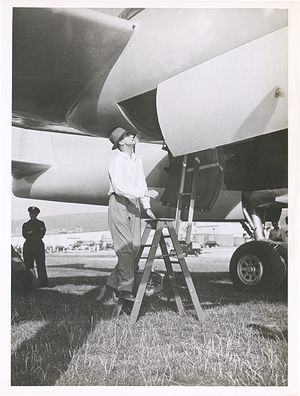PlaneSpottingWorld welcomes all new members! Please gives your ideas at the Terminal.
Hughes XF-11
| XF-11 | |
|---|---|
| Type | Reconnaissance |
| Manufacturer | Hughes |
| Designed by | Howard Hughes |
| Maiden flight | 7 July 1946 |
| Status | Cancelled |
| Primary user | U.S. Army Air Force (intended) |
| Number built | 2 |
The Hughes XF-11 was a prototype military reconnaissance aircraft, designed and flown by eccentric millionaire Howard Hughes for the United States Army Air Force. Despite promise, the XF-11 suffered a disastrous crash that nearly took the life of its designer who acted as a test pilot. The program never recovered from this setback.
Contents
Design and development
The aircraft was designed to meet the same requirements as the Republic XF-12; specifications called for a fast, long ranging photo-reconnaissance aircraft. Said to be a scaled-up version of the earlier Hughes D-2, the final design was similar in general appearance to the famous Lockheed P-38 Lightning [1]. It was a tricycle-gear, twin-engine, twin-boom all-metal monoplane with a pressurized central crew nacelle, with a much larger span and much higher aspect ratio than the P-38's wing.
The XF-11 used Pratt & Whitney R-4360-31 28-cylinder radial engines with twin four-bladed, controllable-pitch propellers at the front of each engine. The propeller design was very unusual in that the front and rear propellers on each engine were counter-rotating, which can increase a propeller-driven aircraft's performance and stability, but which can also add much mechanical complexity.
The Army originally ordered 100 of them for the purposes of photo reconnaissance. The order was cancelled following the end of World War II, leaving Hughes with two prototypes.
Testing
The first prototype, piloted by Hughes himself, crashed on 7 July 1946 while on its maiden flight. An oil leak caused the right-hand propeller controls to lose their effectiveness and the rear propeller subsequently reversed its pitch, disrupting much of that engine's thrust which made the aircraft yaw hard to the right and extraordinarily difficult to control.[2] Rather than feathering the propeller Hughes elected to make an emergency landing on the Los Angeles Country Club's golf course, but about 300 yards short of the course, the aircraft suddenly lost altitude and clipped three houses. The third house was completely destroyed by the fire resulting from the crash and Hughes was nearly killed. [3]
The second prototype was fitted with conventional propellers and flown on 5 April 1947, after Hughes had recuperated from his injuries. This test flight was uneventful and the aircraft proved to be stable and controllable at high speed. However, it was lacking in low-speed stability as the ailerons were ineffective at low altitudes [4] and when the Air Force evaluated it against the XF-12, testing revealed the XF-11 was harder to fly and maintain, and projected to be twice as expensive to build. A small production order for the XF-12 went out but the USAF chose the Boeing RB-50 instead, which had similar long-range photo-reconnaissance capability and was available for much less cost.
Specifications (XF-11)
General characteristics
- Crew: two; pilot and navigator/photographer
- Length: 65 ft 5 in (19.94 m)
- Wingspan: 101 ft 4 in (30.89 m)
- Height: 23 ft 2 in (7.06 m)
- Wing area: 983 ft² (91.3 m²)
- Empty: 37,100 lb (16,800 kg)
- Loaded: lb ( kg)
- Maximum takeoff: 58,300 lb (26,400 kg)
- Powerplant: 2x Pratt & Whitney R-4360-31 radials, 3,000 hp (2,240 kW) each
Performance
- Maximum speed: 450 mph (720 km/h)
- Range: 5,000 miles (8,000 km)
- Service ceiling: 44,000 ft (13,415 m)
- Rate of climb: ft/min ( m/min)
- Wing loading: lb/ft² ( kg/m²)
- Power/Mass: hp/lb ( kW/kg)
References
- ↑ Winchester 2005, p. 222.
- ↑ Winchester 2005, p. 223.
- ↑ XF-11 Crash site
- ↑ Winchester 2005, p. 223.
- Barton, Charles. "Howard Hughes and the 10,000 ft. Split-S." Air Classics, Vol. 18, no. 8, August 1982.
- Winchester, Jim. "Hughes XF-11." Concept Aircraft: Prototypes, X-Planes and Experimental Aircraft. Kent, UK: Grange Books plc., 2005. ISBN 1-84013-309-2.
External links
Related content
Related development
Comparable aircraft
Designation sequence
F-8 -
F-9 -
F-10 -
XF-11 -
XF-12 -
F-13 -
F-14
Related lists
Lists relating to aviation | |
|---|---|
| General | Timeline of aviation · Aircraft · Aircraft manufacturers · Aircraft engines · Aircraft engine manufacturers · Airports · Airlines |
| Military | Air forces · Aircraft weapons · Missiles · Unmanned aerial vehicles (UAVs) · Experimental aircraft |
| Notable incidents and accidents | Military aviation · Airliners · General aviation · Famous aviation-related deaths |
| Records | Flight airspeed record · Flight distance record · Flight altitude record · Flight endurance record · Most produced aircraft |

